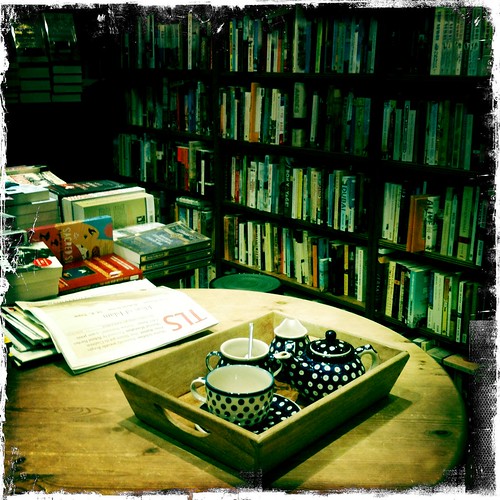As someone who’s done plenty of readings at bookstores (and, I hope, will do plenty more in 2016!), I really appreciate the thinking behind Morioka Shoten, a bookstore in Tokyo which only stocks a single book each week.
Morioka Shoten is a tiny bookstore of “a Single Room with a Single Book” in Tokyo. It sells only one book; more precisely, multiple copies of one title that changes weekly, with a small book-inspired art exhibition on the walls. Its challenging, minimalistic philosophy and well-curated shows attract numerous visitors from all over the world…. It’s a place where a blissed conversation between readers and authors emerges through slow reading – just like a Japanese traditional tea room.
As owner Yoshiyuki Morioka explains in The Guardian:
This bookstore that sells only one book could also be described as ‘a bookstore that organises an exhibition derived from a single book’. For instance, when selling a book on flowers, in the store could be exhibited a flower that actually appears in the book. Also, I ask the authors and editors to be at the bookstore for as much time as possible. This is an attempt to make the two-dimensional book into three-dimensional ambience and experience. I believe that the customers, or readers, should feel as though they are entering ‘inside a book’.
It’s completely different from the kinds of bookstores we’re familiar with, but I’d be interested to see what it’s like for myself. For me, part of the pleasure of bookstores is that they’ve got lots of books, and afford a measure of serendipity: you wander in just to have a look, and walk out with an armful of books you never knew existed.
What I’m thinking about is a bookstore like this one in Vienna (the picture is mine from a couple years ago):
Or the magnificent Topping and Company, in the wonderful medieval town of Ely:
Compare that to Morioka Shoten (from Takram Design Engineering):

Earlier this week, my daughter took me to Alegio Chocolate, a store in Palo Alto that sells chocolate that’s grown and processed from a plantation in São Tomé and Príncipe. You eat it incredibly slowly: it’s so pure, and real chocolate is so complex and unfamiliar, that you need to really take your time with it. (It’s also eye-waveringly expensive, thanks to the total absence of vanilla, soy lecithin, and other additives.) It makes for a very different experience than you normally have with even good chocolate: it requires a kind of patience and concentration that we don’t normally given to food. It would be really interesting to have that same experience applied to a book.

